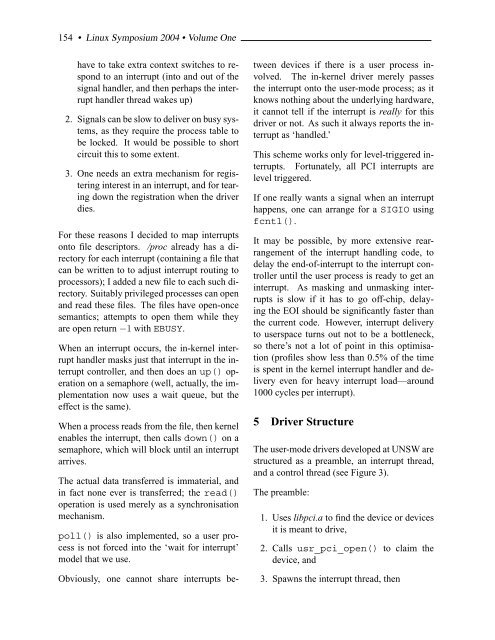Create successful ePaper yourself
Turn your PDF publications into a flip-book with our unique Google optimized e-Paper software.
154 • <strong>Linux</strong> Symposium 2004 • Volume <strong>One</strong><br />
have to take extra context switches to respond<br />
to an interrupt (into and out of the<br />
signal handler, and then perhaps the interrupt<br />
handler thread wakes up)<br />
2. Signals can be slow to deliver on busy systems,<br />
as they require the process table to<br />
be locked. It would be possible to short<br />
circuit this to some extent.<br />
3. <strong>One</strong> needs an extra mechanism for registering<br />
interest in an interrupt, and for tearing<br />
down the registration when the driver<br />
dies.<br />
For these reasons I decided to map interrupts<br />
onto file descriptors. /proc already has a directory<br />
for each interrupt (containing a file that<br />
can be written to to adjust interrupt routing to<br />
processors); I added a new file to each such directory.<br />
Suitably privileged processes can open<br />
and read these files. <strong>The</strong> files have open-once<br />
semantics; attempts to open them while they<br />
are open return −1 with EBUSY.<br />
When an interrupt occurs, the in-kernel interrupt<br />
handler masks just that interrupt in the interrupt<br />
controller, and then does an up() operation<br />
on a semaphore (well, actually, the implementation<br />
now uses a wait queue, but the<br />
effect is the same).<br />
When a process reads from the file, then kernel<br />
enables the interrupt, then calls down() on a<br />
semaphore, which will block until an interrupt<br />
arrives.<br />
<strong>The</strong> actual data transferred is immaterial, and<br />
in fact none ever is transferred; the read()<br />
operation is used merely as a synchronisation<br />
mechanism.<br />
poll() is also implemented, so a user process<br />
is not forced into the ‘wait for interrupt’<br />
model that we use.<br />
Obviously, one cannot share interrupts between<br />
devices if there is a user process involved.<br />
<strong>The</strong> in-kernel driver merely passes<br />
the interrupt onto the user-mode process; as it<br />
knows nothing about the underlying hardware,<br />
it cannot tell if the interrupt is really for this<br />
driver or not. As such it always reports the interrupt<br />
as ‘handled.’<br />
This scheme works only for level-triggered interrupts.<br />
Fortunately, all PCI interrupts are<br />
level triggered.<br />
If one really wants a signal when an interrupt<br />
happens, one can arrange for a SIGIO using<br />
fcntl().<br />
It may be possible, by more extensive rearrangement<br />
of the interrupt handling code, to<br />
delay the end-of-interrupt to the interrupt controller<br />
until the user process is ready to get an<br />
interrupt. As masking and unmasking interrupts<br />
is slow if it has to go off-chip, delaying<br />
the EOI should be significantly faster than<br />
the current code. However, interrupt delivery<br />
to userspace turns out not to be a bottleneck,<br />
so there’s not a lot of point in this optimisation<br />
(profiles show less than 0.5% of the time<br />
is spent in the kernel interrupt handler and delivery<br />
even for heavy interrupt load—around<br />
1000 cycles per interrupt).<br />
5 Driver Structure<br />
<strong>The</strong> user-mode drivers developed at UNSW are<br />
structured as a preamble, an interrupt thread,<br />
and a control thread (see Figure 3).<br />
<strong>The</strong> preamble:<br />
1. Uses libpci.a to find the device or devices<br />
it is meant to drive,<br />
2. Calls usr_pci_open() to claim the<br />
device, and<br />
3. Spawns the interrupt thread, then

















